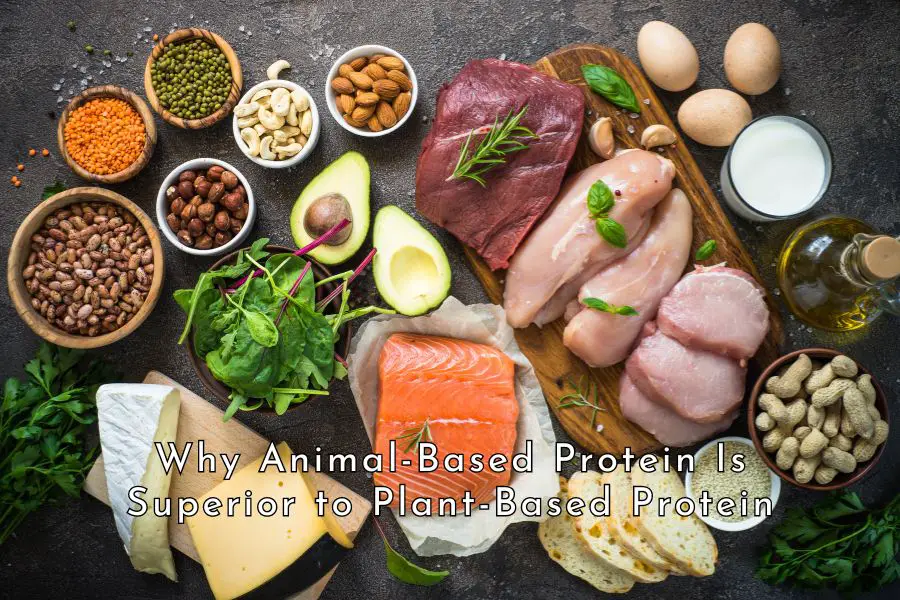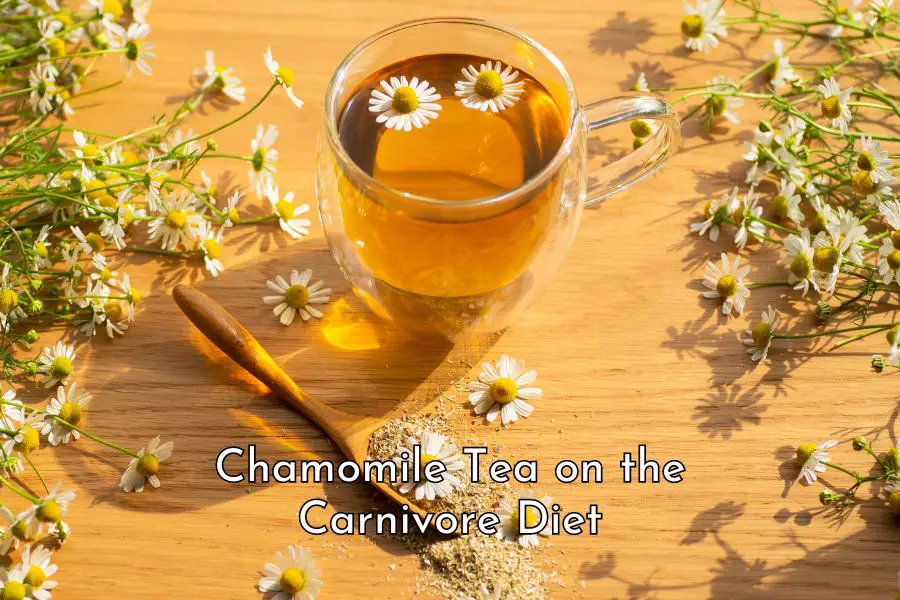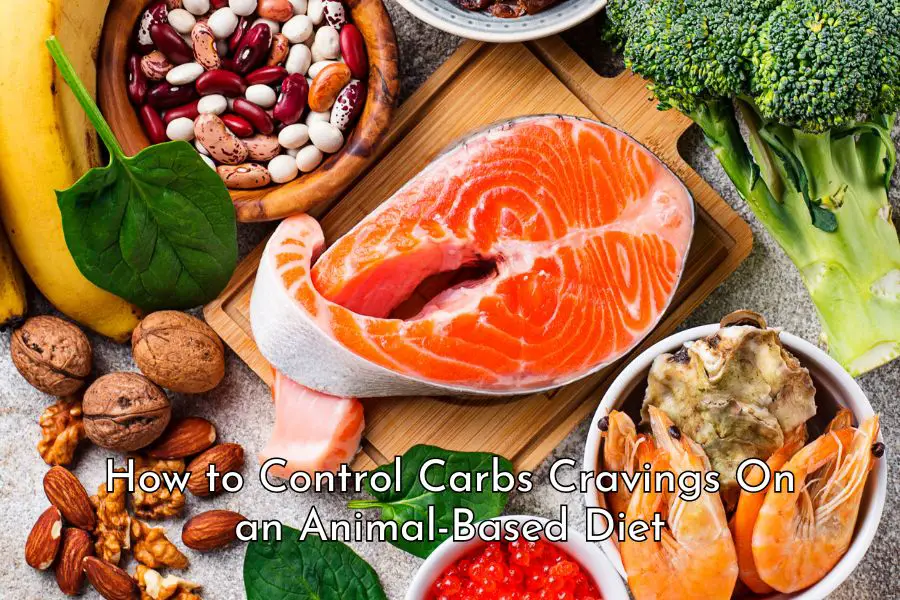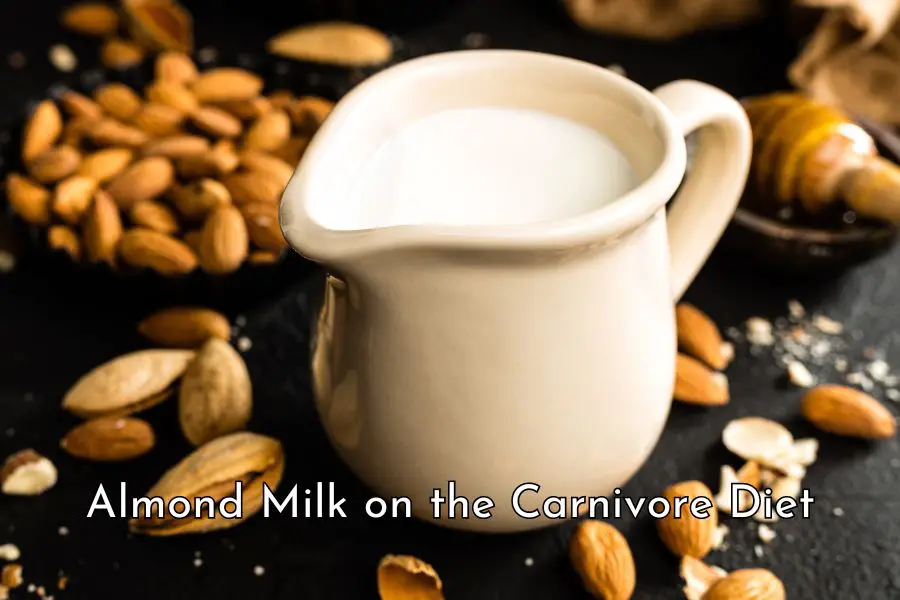With the increasing popularity of vegan and vegetarian diets and the growing plant-based movement, debates around the quality and benefits of animal proteins versus plant proteins continue to persist. In this article, we will argue that animal-based protein is undeniably superior to plant-based protein.
If our goal is to survive, sure, we will just have to take whatever protein sources available to us. However, when we have the freedom to choose the best source of proteins to support our wellbeing and help us thrive, animal proteins emerge as the superior choice in terms of quality, nutritional content, bioavailability, toxin load, and muscle synthesis.
Animal Proteins Are Complete Protein
Animal-based proteins from sources such as meat, dairy, and eggs provide a complete amino acid profile, containing all the essential amino acids that the human body cannot produce on its own. This completeness is essential for overall health and proper bodily functions. On the other hand, plant-based proteins are typically incomplete proteins because they lack or have low amounts of one or more essential amino acids.
While hundreds of amino acids exist in nature, only about 20 are required to create all the proteins found in the human body and most other forms of life. Of these 20 amino acids, the nine amino acids listed below are considered essential because the human body cannot make on its own and must get them from dietary sources: [1]
- Phenylalanine
- Valine
- Tryptophan
- Threonine
- Isoleucine
- Methionine
- Histidine
- Leucine
- Lysine
Other amino acids are considered non-essential or dispensable amino acids and can be excluded from a diet because the human body can synthesize these amino acids using only the essential amino acids.
However, amino acids such as arginine, cysteine, glutamine, and glycine might be deemed conditionally essential or semi-essential since the body cannot synthesize them in adequate amounts during specific physiological stages like pregnancy, adolescent growth, or recovery from trauma. In such instances, the consumption of animal-based proteins become even more important. [2, 3, 4, 5]
While animal-based food contains all nine essential amino acids in the right proportions, plant-based foods, except for soy, provide incomplete proteins because they typically lack or have insufficient levels of one or more essential amino acids. [6]
For example, legumes (beans, lentils, peas) are generally low in methionine, a building block for proteins that plays a key role in various metabolic processes as well as involves in antioxidant processes. On the other hand, grains (wheat, rice, oats) are typically low in lysine which is critical for protein synthesis, collagen formation, and immune function. [7, 8, 9, 10]
If you are not on a carnivore diet, it is important to carefully construct your diet in order to get all the essential amino acids from a variety of sources.
It is not difficult for those on a vegetarian diet to get adequate amount of quality proteins if they include plenty of fish, eggs, and dairy products in their diet. However, those who are on a vegan diet will need to include food that offer complete protein profiles like soy, quinoa, and hemp seed or combine different plant-based groups (e.g. beans and rice; legumes and nuts; or grains and nuts). [11]
Animal Proteins Are Extremely Nutrient Dense
When you eat animal-based food, you not only get complete proteins but also a wide range of beneficial essential nutrients like vitamin B12, iron, zinc, and omega-3 fatty acids. While some plant-based sources contain these nutrients, they may be in different forms or less readily absorbed by the body.
Vitamin B12
Animal-based food is an excellent source of vitamin B12, an essential nutrient which plays several crucial roles in the human body, including: [12, 13, 14]
- Aiding in DNA production and cell division
- Supporting the maturation of red blood cells to prevent anemia
- Maintaining the proper functioning of the nervous system
- Working together with folate (vitamin B9) in various metabolic processes, including the conversion of homocysteine to methionine
- Participating in the metabolism of fatty acids and amino acids and contributing to the production of energy in the body.
A deficiency in vitamin B12 can lead to various health issues, including anemia, neurological problems, and potentially irreversible nerve damage.
As plant-based food does not contain B12, it is particularly important for individuals following vegetarian or vegan diets to ensure they obtain adequate B12 through fortified foods or supplements.
Heme Iron
Animal-based food is a great source of quality and highly bio-available iron which is an essential mineral that plays a crucial role in various physiological processes, including oxygen transport, DNA synthesis, and energy production. [15, 16, 17]
Iron is present in two main forms in the diet, heme iron and non-heme iron, which have different characteristics and are absorbed differently by our bodies. [18]
Heme iron is found in animal-based foods, particularly in red meat, poultry, and fish. Heme iron is part of the hemoglobin and myoglobin molecules, which are proteins responsible for oxygen transport in red blood cells and muscle cells, respectively. [19]
Non-heme iron is found in both animal-based food (meat, dairy and eggs) and plant-based foods (beans, lentils, tofu, chickpeas, fortified cereals). However, plant-based food only contains non-heme iron. [20]
Heme iron is generally more easily absorbed by the body compared to non-heme iron. In addition, with more than 95% of functional iron in the human body being in the form of heme iron, not just iron but heme iron should be considered an essential nutrient for human health. [21, 22]
Therefore, those who don’t eat meat (vegans and vegetarians) would be at an increased risk of iron-deficiency anemia than those who do. They would not get the essential heme iron and their non-heme iron intake may not be sufficient.
As mentioned above, non-heme iron is generally less efficiently absorbed (2%-20%) than heme iron. The absorption of non-heme iron is influenced by various dietary factors such as vitamin C content and the presence of inhibitors. For example, phytic acid (found in whole grains and legumes) and polyphenols (found in tea and coffee) can inhibit the absorption of both heme and non-heme iron while calcium and some dietary fibers may also modestly reduce non-heme iron absorption. [23]
Zinc
Animal-based food is also a great source of zinc, an essential trace element that plays a critical role in various physiological processes within the human body. Plant-based food, however, is not a good source of zinc due to the presence of compounds like phytates, which can limit zinc absorption. [24, 25, 26]
Zinc is involved in many important several biological processes of the human body, including enzyme catalysis, immune function, wound healing, DNA synthesis and repair, protein synthesis, hormone regulation, antioxidant defense, regulation of neurotransmitters, collagen synthesis, and bone health. [27, 28, 29]
A deficiency in zinc can lead to many serious health problems, including impaired growth and development, compromised immune function, digestive issues, reproductive problems, delayed wound healing, impaired cognitive and psychological function, hair loss, weight gain, and loss of appetite. [30, 31]
Zinc must be obtained through the diet and the best sources of zinc are animal-based foods such as meat, seafood, eggs and dairy products. Oysters, crab, shrimp, beef, lamb, pork, turkey, chicken, and lobster are especially high in zinc. For example, a three-ounce serving of oysters provides 291% of RDA for zinc while the same serving of beef provides 35% of RDA. [32, 33, 34, 35, 36, 37, 38]
Plant-based foods like nuts, seeds, lentils, beans, and whole grains contain a reasonable amount of zinc. However, their bioavailability is notably lower compared to animal-based foods due to the presence of plant compounds such as phytates. These compounds can bind to zinc, forming complexes that reduce its accessibility for absorption in the digestive tract. [39, 40]
Omega-3 Fatty Acids
Animal-based foods are considered superior sources of omega-3 fatty acids, a vital nutrient crucial for supporting heart health, brain function, and mitigating inflammation in the human body. In contrast, plant-based foods predominantly offer ALA, a less active form of omega-3 fatty acids that the human body utilizes less efficiently. [41]
Omega-3 fatty acids are essential components of the human diet, playing pivotal roles in various physiological processes that contribute to overall health, including: [42, 43, 44, 45, 46, 47]
- Maintaining heart health by reducing triglyceride levels, lowering blood pressure, and mitigating the risk of cardiovascular diseases
- Improving cognitive function, memory, and overall neurological health
- Regulating the body’s immune responses and potentially alleviating symptoms associated with chronic inflammatory conditions like arthritis
- Supporting skin and joint health
- Enhancing eye health and lowering the risk of age-related macular degeneration
- Contributing to the growth of the fetal brain and eyes during pregnancy
- Supporting mental health. Some evidence suggests that omega-3s may have a positive impact on mood disorders, such as depression and anxiety.
Inadequate intake of omega-3 fatty acids can result in a number of health issues including cardiovascular problems, cognitive impairment, inflammatory conditions, skin and joint issues, poor pregnancy outcomes, and mood disorders. [48, 49, 50, 51, 52]
There are several types of omega-3 fatty acids but the majority of scientific research focuses on three types: alpha-linolenic acid (ALA), eicosapentaenoic acid (EPA), and docosahexaenoic acid (DHA). [53]
Animal-based sources such as salmon, mackerel, herring, tuna, trout, animal brains, and animal fats provide both EPA and DHA which can be readily absorbed and utilized by the body.
Plant-based omega-3 sources, such as flaxseeds, chia seeds, and walnuts, however, provide only ALA which is an inactive form and must be converted to EPA and DHA so that they can be used in various physiological functions listed above.
However, humans have a very limited ability to convert ALA to beneficial EPA and DHA forms. It is estimated that, in healthy adults, around 5% of ALA is converted to EPA and less than 1% of ALA is converted to DHA. [54, 55, 56]
Animal Proteins Are Highly Bioavailable
Animal proteins are considered more bioavailable than plant proteins. This means that the body can absorb and utilize the essential amino acids more efficiently.
One indicator of protein quality is the protein digestibility-corrected amino acid score (PDCAAS), which assesses protein quality based on human essential amino acid requirements and our ability to digest it. Introduced in 1989 by FAO and WHO, PDCAAS has been widely used as a preferred method preferred method to evaluate a food’s protein quality.
The table below shows animal based proteins consistently have better digestibility scores than plant-based proteins. [57, 58]
| Protein Type | PDCAAS |
|---|---|
| Eggs | 1.00 |
| Milk | 1.00 |
| Casein | 1.00 |
| Whey protein | 1.00 |
| Soy protein | 1.00 |
| Black beans | 0.75 |
| Pea | 0.59 |
| Peanut | 0.52 |
| Rice | 0.50 |
| Wheat gluten | 0.25 |
Not only animal-based proteins have higher PDCAAS compared to plant-based proteins, the essential vitamins and minerals in animal food sources are also a lot more bioavailable than those come from plant foods.
For example, vitamin A from animal-sources is preformed vitamin A which your body can readily use and absorbed. Plant foods, however, provide only provitamin A carotenoids, which are precursors that your body needs to convert into vitamin A in the intestine. [59]
Animal Proteins Have a Low Toxin Content
Animal-based protein sources have a lower toxin content than plant-based protein sources due to the presence of plant anti-nutrients.
Plant anti-nutrients are naturally occurring compounds in plant-based foods that can interfere with the absorption or utilization of nutrients in the human body. While many plant-based foods are rich in essential nutrients, some also contain anti-nutrients that interfere with nutrition absorption as well as cause numerous health issues if consumed in excessive amounts. [60, 61]
Some well-known anti-nutrients include phytates, lectins, tannins, oxalates, cyanide, protease inhibitors, and goitrogens.
For instance, phytates, present in whole grains, legumes, nuts, and seeds, can bind to minerals such as calcium, iron, and zinc, thereby reducing their absorption in the digestive tract. Lectins, found in legumes, grains, and certain vegetables, can interfere with nutrient absorption by binding to carbohydrates. Additionally, they may exhibit agglutinating properties, causing red blood cells to clump together. Oxalates, found in spinach, beets, rhubarb, nuts, and certain berries, can form crystals, potentially leading to the development of kidney stones in susceptible individuals. Furthermore, oxalates can bind to calcium, diminishing its absorption. [62, 63, 64, 65]
Animal-based food, on the other hand, are free of all these anti-nutrients and, as a result, your body may not need to consume as much of the essential nutrients to meet its functioning needs. You are also less likely to suffer from health issues related to those anti-nutrients such as kidney stones, digestive tract issues, and thyroid dysfunction. [66, 67, 68]
Animal Proteins Are Best for Optimal Muscle Development and Repair
Protein is integral to muscle building and repair, serving as the essential building blocks (amino acids) required for muscle protein synthesis. Engaging in activities like resistance training or exercise induces micro-tears in muscle fibers. The body utilizes these amino acids to generate new proteins, facilitating the repair of damaged muscle tissue and fostering muscle growth.
Animal proteins, with their superior amino acid profiles, rich essential nutrient content, and higher bioavailability, have been found to be better than plant proteins in supporting muscle development and repair, particularly in younger adults. [69, 70].
Conclusion
Not all proteins are equal; 20 grams of complete plant proteins differ significantly from 20 grams of unprocessed animal proteins. While plant-based meat manufacturers aim to replicate the taste and nutritional profile of red meat, laboratory analysis revealed a 90% difference in metabolite abundances between the plant-based meat alternative and grass-fed ground beef. [71]
Large differences in metabolites within various nutrient classes (e.g., amino acids, dipeptides, vitamins, phenols, tocopherols, and fatty acids) with physiological, anti-inflammatory, and/or immunomodulatory roles indicate that these products [plant-based meat alternative and grass-fed ground beef] should not be viewed as truly nutritionally interchangeable, but could be viewed as complementary in terms of provided nutrients.
Vliet et al (2021)
If your goal is optimal health, there is no doubt that animal proteins should be an integral part of your diet. Animal proteins are superior to plant proteins due to their complete amino acid profiles, abundant nutrient content, high bioavailability, minimal toxin loads, and their capacity to facilitate muscle synthesis.
Other posts you might be interested in:
What Is the Best Meat to Eat on the Carnivore Diet?
Ground Beef Nutrition: Your Comprehensive Guide
Is Carnivore the Best Anti-Aging Diet Around?
Why You Should Avoid Farmed Salmon on the Carnivore Diet
How to Carnivore Diet While Traveling
10 Tips to Sneak More Organ Meat into Your Children’s Diet
11 Common Carnivore Diet Mistakes
Disclaimer: The information in this post is for reference purposes only and is not intended to constitute or replace professional medical advice. Please consult a qualified medical professional before making any changes to your diet or lifestyle. Please check out our disclaimer for more detail.





